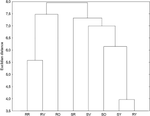Chemoecology ( IF 1.8 ) Pub Date : 2021-08-14 , DOI: 10.1007/s00049-021-00360-6 Bruno H. S. Souza 1 , Eduardo N. Costa 2 , Zulene A. Ribeiro 2 , Mara C. P. Cruz 2 , Arlindo L. Boiça Júnior 2 , Bruno Perlatti 3 , Moacir R. Forim 3 , Michael J. Stout 4

|
Numerous species of herbivorous insects are associated with soybeans, including the specialist velvetbean caterpillar (VBC), Anticarsia gemmatalis, and the generalist fall armyworm (FAW), Spodoptera frugiperda. Expression of plant resistance is influenced by factors intrinsic to host plants, such as leaf age and plant stage, which can differentially affect specialist and generalist insects due to varying levels of plant defense and corresponding insect adaptation. In this study, four experiments were carried out to test the hypotheses that levels of antibiosis-resistance to VBC and FAW in the resistant genotype PI 227,687 and susceptible genotype IGRA RA 626 RR are related to leaf age and plant stage of soybean. Furthermore, the concentrations of nutrients and selected flavonoids were quantified to give insights into possible chemical mechanisms underlying the resistance. As results, development of VBC and FAW were negatively affected when larvae fed leaves of the resistant genotype, older leaves from the lower part of plants, or leaves from reproductive-stage soybeans. The effects were partly different for each insect species, and the generalist FAW was more affected by higher resistance levels in the older leaves of soybean than the specialist VBC. Distribution and concentrations of nutrients and flavonoids in soybean in function of leaf age and plant stage may explain the varying levels of antibiosis-resistance to VBC and FAW. These results can benefit developments of specific protocols for screening resistant soybean genotypes and pest management strategies focused in plant parts and growth stages that insect-resistance levels are lowest.
中文翻译:

大豆叶龄和植株阶段影响绒毛虫和秋粘虫抗性表达
许多种类的食草昆虫都与大豆有关,包括专科绒毛虫 (VBC)、Anticarsia gemmatalis和通才秋粘虫 (FAW)、草地贪夜蛾 ( Spodoptera frugiperda). 植物抗性的表达受寄主植物固有因素的影响,例如叶龄和植物阶段,由于植物防御和相应的昆虫适应水平不同,这些因素会对专科昆虫和通才昆虫产生不同的影响。在这项研究中,进行了四个实验来检验抗性基因型 PI 227,687 和易感基因型 IGRA RA 626 RR 中对 VBC 和 FAW 的抗菌抗性水平与大豆叶龄和植株阶段相关的假设。此外,还对营养素和选定的黄酮类化合物的浓度进行了量化,以深入了解抗性背后可能的化学机制。结果,当幼虫以抗性基因型的叶子、植物下部的老叶子、或来自生殖期大豆的叶子。每种昆虫物种的影响部分不同,与专家 VBC 相比,通才 FAW 受大豆老叶更高抗性水平的影响更大。大豆中营养素和黄酮类化合物的分布和浓度随叶龄和植物阶段的变化而变化,可以解释对 VBC 和 FAW 的不同程度的抗菌抗性。这些结果有利于筛选抗性大豆基因型的特定方案和害虫管理策略的开发,这些策略侧重于昆虫抗性水平最低的植物部分和生长阶段。大豆中营养素和黄酮类化合物的分布和浓度随叶龄和植物阶段的变化而变化,可以解释对 VBC 和 FAW 的不同程度的抗菌抗性。这些结果有利于筛选抗性大豆基因型的特定方案和害虫管理策略的开发,这些策略侧重于昆虫抗性水平最低的植物部分和生长阶段。大豆中营养素和黄酮类化合物的分布和浓度随叶龄和植物阶段的变化而变化,可以解释对 VBC 和 FAW 的不同程度的抗菌抗性。这些结果有利于筛选抗性大豆基因型的特定方案和害虫管理策略的开发,这些策略侧重于昆虫抗性水平最低的植物部分和生长阶段。



























 京公网安备 11010802027423号
京公网安备 11010802027423号